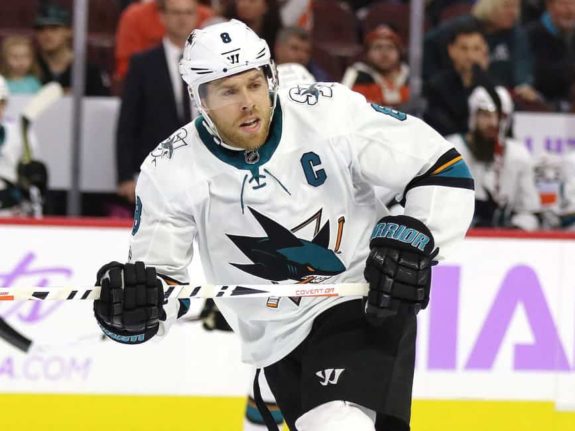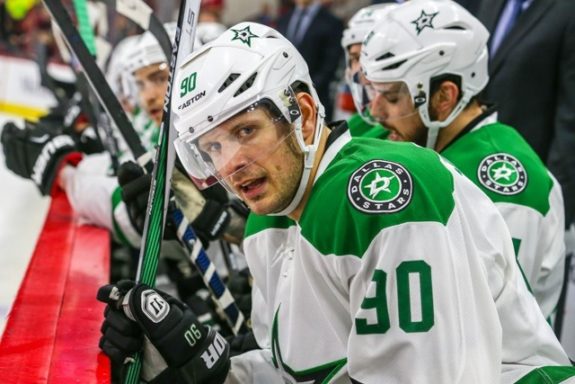It’s odd to think of Corey Perry as an ex-star, but that’s exactly what he is. Oh, he may have just signed with the Dallas Stars, but, as an ex-Hart Memorial Trophy winner (2010-11) coming off a 10-point season, Perry is not the top-line player he once was. The Stars must realize just that with regard to how they deploy him during the upcoming 2019-20 season.
Perry’s Poor 2018-19
In Perry’s defense, the 10 points did come over 31 games, as the winger missed 51 recovering from knee surgery. However, all that serves is a cruel reminder of how fickle a mistress time can be. It’s been some time since Perry was a legitimate offensive threat. He scored 34 goals in 2015-16 and missed the twenties altogether the next season, falling to 19 in 2016-17 and then 17 in 2017-18. He scored just six times last season, adding four assists.

As a result, Perry became the first Hart winner to be bought out in the salary-cap era. The good news for Perry is he’ll still earn some of the money he would have been owed over the final two seasons of his original eight-year, $69 million deal with the Anaheim Ducks. That translates to an ideal scenario for any team looking to take a flier on a former most-valuable player willing to sign a short-term contract to prove himself. Enter the Stars, who answered the call with a bonus-laden one-year, $1.5 million contract.
Perry vs. Pavelski
After falling to the eventual-Stanley Cup-champion St. Louis Blues in seven games, the Stars have to be considered legitimate contenders. And that was before their successful offseason, during which they secured the rights to one of the top free agents available in top-six center Joe Pavelski. Granted, Pavelski is 35 and the Stars are taking a chance, paying him $7 million on average for each of the next three seasons until he’s going to be 37 going on 38.

Nevertheless, Pavelski is still scoring at a high level. He’s coming off a 38-goal, 64-point season. So, there must be some sense of optimism that Perry, who’s a year younger than Pavelski, can rediscover his scoring touch, especially with a fire lit in him after having the Ducks sever all ties, despite having had a relationship with him dating back to 2003.
It’s unlikely to happen, though. They’re two different players. The analytics show Perry can still have an impact, but realistically only in a bottom-six role. The Stars must understand that, because, even if Perry qualifies for all his bonus money, he’ll still only be paid as their sixth-best forward, in a tie with Andrew Cogliano.
Granted, one of the five above him is Martin Hanzal, who’s done very little in his two injury-plagued seasons with the Stars. However, Roope Hintz, who’s due to break out in sophomore season by potentially centering the second line, is only on his entry-level deal. So, it evens out and Perry should rationally be seen as a bottom-six forward on the team, albeit one with impressive depth up front.
Perry vs. Spezza
Maybe the Stars have learned somewhat from the Hanzal deal. You don’t need to look back nearly that far after they just parted ways with Jason Spezza, though. After signing Spezza to a four-year, $30 million deal as a 31-year-old, the Stars saw firsthand that age and the speed of the NHL game don’t generally mix. As a result, rookie head coach Jim Montgomery limited his ice time to 13:16 per game during the regular season. That was 22nd-best on the Stars.

In the playoffs, Spezza, who was healthy-scratched at times, played just 10:03 per game. He nevertheless found a regular shift on the power play and tied Alexander Radulov for first on the team with three points on the man advantage. His five points overall ranked seventh on the team, one above rookie-standout Miro Heiskanen. So, it’s not Pavelski to whom Stars fans should be comparing Perry. It’s to Spezza, who ended up signing a sweetheart deal of his own, getting just $700,000 to play for the Toronto Maple Leafs.
Consider how Perry scored the fourth-most power-play points on the Ducks in his last full season there in 2017-18 (fifth-most amount of power-play ice time), when he was already in noticeable decline. Maybe the Stars and Montgomery can draw from their own modest success, managing Spezza down the stretch. With Perry due only a fraction of the amount Spezza was paid, the optics are already much better this time around, even if it’s mostly Pavelski, Tyler Seguin, Jamie Benn and Alexander Radulov who will be leaving stars in fans’ eyes.
It may only end up being one and done for Perry in Dallas, but the team as a whole is a very good one. All he needs to do is find his niche with the help of Montgomery and play his heart out in the role he lands. As long as he’s okay not being the name on the marquee, Perry stands to write a decent comeback story. It may be far away from the bright lights of Hollywood, but it at least likely comes with another kick at the can past this season. Perry may no longer be a star, but he isn’t necessarily completely burnt out.